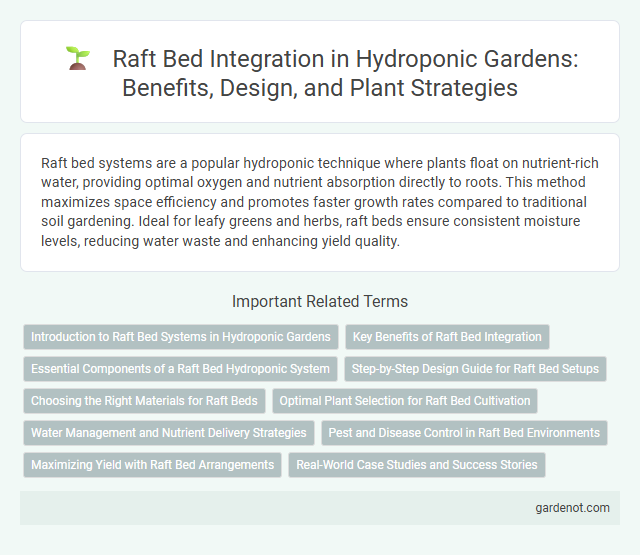Raft bed systems are a popular hydroponic technique where plants float on nutrient-rich water, providing optimal oxygen and nutrient absorption directly to roots. This method maximizes space efficiency and promotes faster growth rates compared to traditional soil gardening. Ideal for leafy greens and herbs, raft beds ensure consistent moisture levels, reducing water waste and enhancing yield quality.
Introduction to Raft Bed Systems in Hydroponic Gardens
Raft bed systems, also known as deep water culture, are a popular hydroponic technique where plants float on nutrient-rich water in a shallow container. This method allows roots to remain submerged, providing continuous access to oxygen and nutrients and promoting rapid growth. Ideal for leafy greens and herbs, raft beds optimize space and resource efficiency in hydroponic gardens.
Key Benefits of Raft Bed Integration
Raft bed integration in hydroponic landscapes ensures nutrient-rich water circulation, promoting optimal root oxygenation and consistent growth rates. This system minimizes water usage by recirculating solutions, reducing waste and operational costs. Enhanced plant support and disease control further improve yield quality and crop health in vertical farming setups.
Essential Components of a Raft Bed Hydroponic System
A raft bed hydroponic system relies on essential components including a sturdy floating raft made from polyethylene or Styrofoam that supports plant roots suspended in a nutrient-rich water solution. The system requires an aeration mechanism such as air pumps or diffusers to oxygenate the water, preventing root rot and promoting healthy growth. Additionally, a reservoir to hold the nutrient solution and a water circulation system to ensure consistent flow and nutrient distribution are critical for optimal plant development.
Step-by-Step Design Guide for Raft Bed Setups
A step-by-step design guide for raft bed setups in hydroponic landscapes begins with selecting a durable, water-resistant container that supports plant growth and root expansion. Incorporate a nutrient film technique by ensuring consistent water and nutrient solution circulation using a submersible pump and air stones for oxygenation. Position plants in net pots with growing media, maintaining optimal spacing and light exposure to maximize yield and prevent overcrowding.
Choosing the Right Materials for Raft Beds
Selecting durable, water-resistant materials like high-density polyethylene (HDPE) or food-grade plastic ensures longevity and prevents water contamination in raft beds. Lightweight materials with excellent buoyancy, such as expanded polystyrene foam, provide stable support for plant roots while maintaining optimal oxygen levels. Prioritizing non-toxic, UV-resistant components enhances system sustainability and promotes healthy hydroponic plant growth.
Optimal Plant Selection for Raft Bed Cultivation
Optimal plant selection for raft bed cultivation emphasizes leafy greens such as lettuce, spinach, and kale, which thrive due to their lightweight structure and fast growth rates. Herbs like basil and mint are also ideal, benefiting from consistent nutrient availability and oxygen-rich water in the hydroponic system. Selecting plants with shallow root systems enhances nutrient absorption efficiency and ensures maximum yield in raft bed setups.
Water Management and Nutrient Delivery Strategies
Raft bed hydroponic systems optimize water management by continuously circulating nutrient-rich water beneath the plant roots, ensuring consistent oxygenation and moisture levels. Precision nutrient delivery is achieved through automated pumps and sensors that regulate pH and electrical conductivity (EC) to maintain ideal nutrient balance. This method reduces water wastage and promotes uniform nutrient uptake, enhancing overall crop yield and health in controlled environments.
Pest and Disease Control in Raft Bed Environments
Raft bed hydroponic systems require rigorous pest and disease control measures to maintain healthy plant growth. Utilizing integrated pest management (IPM) strategies, such as biological controls with beneficial insects and regular monitoring for fungal pathogens, helps minimize infestations in the water-based environment. Maintaining optimal water quality and ensuring proper sanitation of the raft bed components are crucial to preventing the spread of root diseases and waterborne pathogens.
Maximizing Yield with Raft Bed Arrangements
Raft bed arrangements maximize hydroponic yield by providing optimal water and nutrient circulation, ensuring consistent plant growth and minimizing nutrient loss. Utilizing a dense planting strategy on floating rafts increases crop output per square meter with improved oxygenation at the root zone. Efficient spacing and raft size customization support scalable production while reducing labor and maintenance costs in hydroponic landscape systems.
Real-World Case Studies and Success Stories
Raft bed hydroponic systems have demonstrated exceptional productivity in commercial leafy greens farms across the United States, such as the Deep Water Culture setup by Gotham Greens in New York, which achieved a 25% yield increase compared to traditional soil methods. In Singapore, AeroFarms' vertical raft bed installations optimize space, reducing water usage by 70% while boosting crop turnover rates, showcasing the efficiency of this system in urban environments. European case studies from the Netherlands highlight Raft bed systems' ability to sustain high growth rates and nutrient consistency, crucial for large-scale basil and lettuce production.
Raft bed Infographic

 gardenot.com
gardenot.com